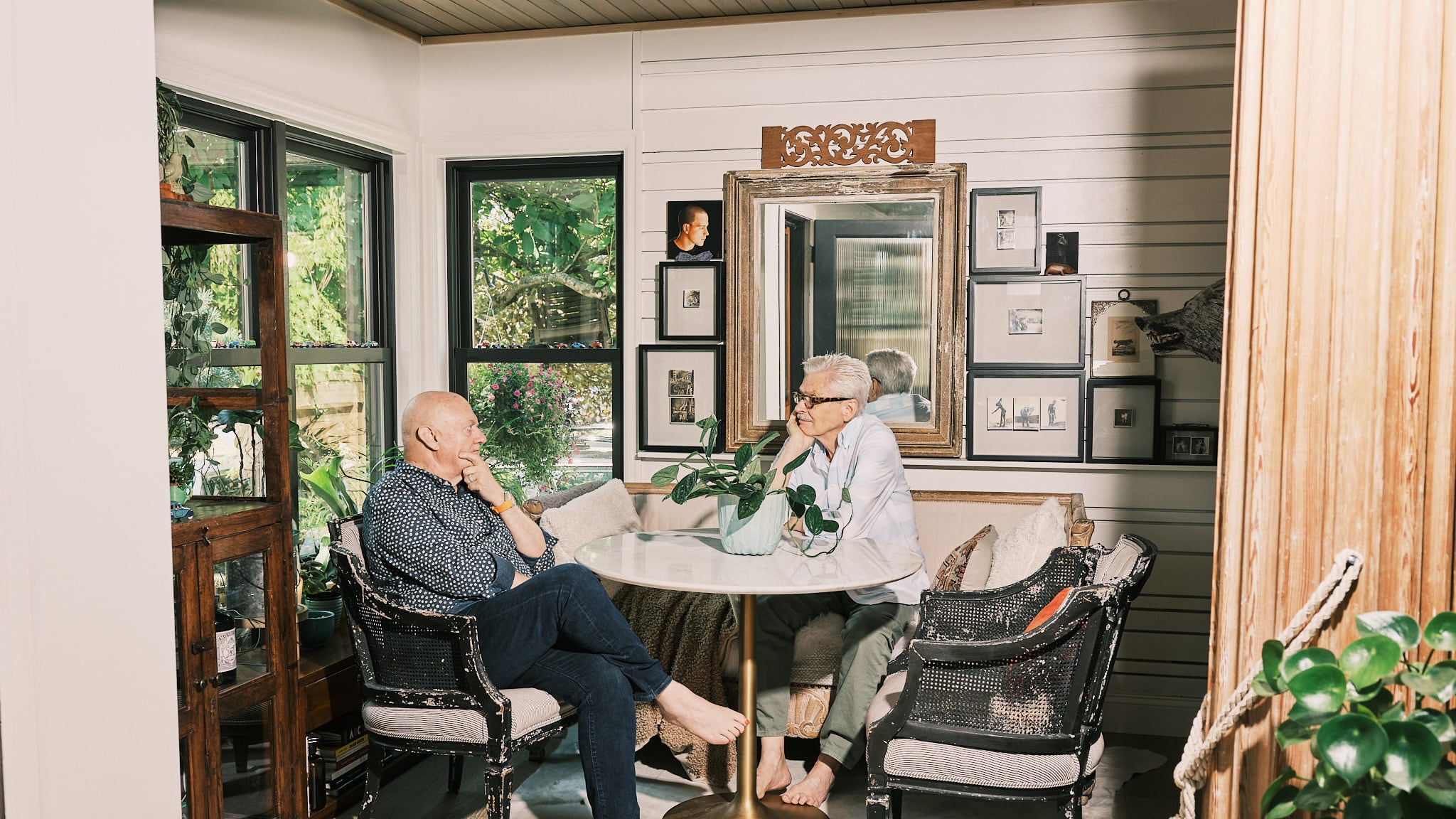It’s hard to know exactly where to settle your eyes on stepping inside Stephen Rutledge and R. Rolfe’s home. The wall of vintage blue-and-green art pottery that separates the kitchen and living room? The procession of wee metal cars lining the rails of the dining-nook windows? The cubbyhole storage packed with cigar boxes and brass-globe cigarette dispensers? The weathered-wood trunk on which metal letters spell out “PENIS”? “I’m definitely a maximalist,” Rutledge says with a laugh, fully aware of the understatement.
But though he’s an inveterate collector—books, toy cars, old cam- eras, shaving brushes, orbs, Catholic iconography, typographic ephemera (“R’s, Q’s, and ampersands are my thing”)—nothing in the house could ever be called clutter. Each room is curated to reflect the couple’s interests in history and storytelling, with objects and vignettes that are witty and thought-provoking—feasts for the eyes served like small plates, one after another.
Rutledge and Rolfe bought the 900-square-foot cottage in 2001, in what Rutledge calls “a sudden, abrupt, midlife-crisis move” from Seattle. Over the ensuing 22 years, they’ve transformed the 1941 home’s boxy layout into a fluid sprawl of rooms unified by design features like salvaged architectural molding, minimal interior doors, and multipurpose spaces that blur indoor-outdoor distinctions.
0 of 13
The free-standing structure in the backyard nicknamed “The Fort” began when Rolfe—a former theatrical set designer who later co-owned downtown Portland shop Boys Fort—built a platform for Rutledge, an actor turned writer, to deliver monologues. Four walls and a roof later, it’s a patchwork of shutters, windows, and corrugated metal that anchors a yard bursting with color and texture. Peonies bloom from reclaimed steel barrels, weathered ladders serve as overhead trellises, and everything from architectural remnants to a rusted child’s tricycle peek out from the surrounding foliage.
Rolfe’s enthusiasm for knocking down and cutting through walls resulted in the house’s most dramatic transformation. “The real estate listing said the back of the garage had a ‘roughed-in bonus room,’” Rutledge recalls, but because there were no windows and no electrical wiring, the couple ignored what they assumed was a small storage or canning room in favor of other projects. “And because we didn’t really go outside to garden then,” Rolfe adds, it was several months before he noticed that the length of the garage relative to that of the house didn’t add up. He recalls shining a Klieg light into the space: “I was like, ‘Oh my god!”
The bonus room became their bedroom after a lengthy remodel that Rutledge tried his best to ignore. “I don’t like the construction part,” he declares. “I like the before and I like the reveal. I do not like the process at all.”
“For two years he refused to look at it,” puts in Rolfe, “and on the last day, I cut a hole through the wall and said, ‘OK, I’ll allow you to come in now.’” (That hole became a doorway hung with tall salvaged doors, sliding open on an iron rail, that Rolfe found at North Mississippi Avenue’s ReBuilding Center.)
Several steps down from the bedroom is the former garage, now Rutledge’s office. At a capacious table, he writes a daily column for The WOW Report, the LGBTQ-focused digital arm of World of Wonder, the production company behind RuPaul’s Drag Race and Million Dollar Listing. Details come into focus everywhere you look: signed cards from Keith Haring gallery shows, antique birdcages, a glass case filled with childhood ephemera.
The room is also home to Rutledge’s collection of letters to and from LGBTQ icons, including Walt Whitman, Cole Porter, and Joan Crawford. Typed missives from Jessica Tandy to Charles Nelson Reilly and Irving Berlin to Leonard Bernstein are among those displayed in a Biedermeier secretary unearthed by Rolfe at a vintage mall and fitted with a magnet-friendly metal backing and silk-lined drawers.
Rutledge reckons Rolfe “could probably live with less stuff,” but the latter also finds inspiration in blending found objects and queer history. One wall of the house’s sitting/guest room is lined with his mixed-media assemblages of collage, wax encaustic, old measuring instruments, antique frames, and salvaged bits of architectural ornament. (One centers an image of William Haines, who gave up a Hollywood acting career that required him to stay closeted and instead became an influential interior decorator; more than one features the actor Adrien Brody.)
Yet Rutledge and Rolfe aren’t sure there’s a connection to be drawn between honoring LGBTQ history and repurposing literal pieces of the past. Their shared, “unexplainable, non-intellectual attraction to architectural elements and fragments” is not unlike their love of rescue dogs (they currently have two) and final-markdown plants: just who they are, just how they live. And in their home, there’s room enough for all of it.
STEPHEN RUTLEDGE & R. ROLFE’S PORTLAND TOP SIX
- FOR PLANTS > Pomarius Nursery
- FOR ANTIQUE FINDS > Monticello Antique Marketplace
- FOR CITY ARCHITECTURE > St. Johns Bridge
- FOR BREAKFAST > Flour Market
- FOR HOME GOODS > Cargo, Kabinett PDX
This story is part of Nester, Willamette Week’s annual home magazine. It is free and can be found all over Portland beginning Friday, Sept. 22, 2023. Find your free copy at one of the locations noted here, before they all get picked up! Or, order one through our store.














